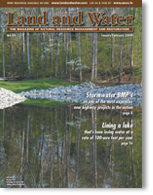Features Available Online
Stormwater Treatment on the Maryland
Intercounty Connection Project
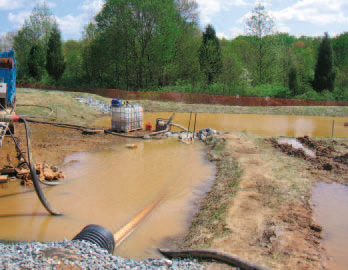
AN east-west highway across the middle of Montgomery County and into western Prince George’s County in Maryland was first proposed as part of a larger Outer Beltway around Washington, D.C. in the 1950s. Although the concept of an Outer Beltway was dropped, the portion known as the Maryland Intercounty Connector (ICC) has been maintained ever since in local planning documents. These planning documents, designed to balance land use, environmental and transportation needs, were continually reviewed and updated by the Maryland National Capital Park and Planning Commission (M-NCPPC) and Montgomery and Prince George’s County governments pursuant to extensive public participation processes.
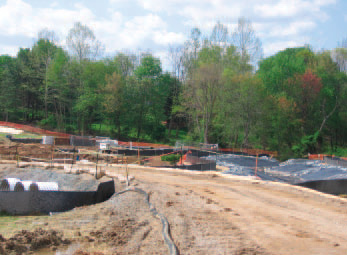
Since the project’s early beginnings nearly 50 years ago, environmental groups and local home owners have been concerned about the environmental impact. Approval for the ICC was given only after Maryland agreed upon mitigations for the environmental, economic, and community requirements. Approved in May of 2006, the project began in the fall of 2007 and is expected to be completed in 2010.
The six-lane, 18-mile toll highway will cut through parkland and residential communities between the Interstate 270 and Interstate 95 corridors across Montgomery and Prince George's coun•ties, claiming nearly 60 homes in its path. The estimated cost is $2.4 billion and could rise to $3 billion with financing costs, making it the most expensive new highway project in the region, and one of the most expensive in the nation.
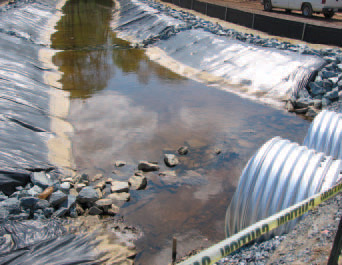
The ICC will link existing and proposed development areas between the I-270/I-370 and I-95/US1 corridors with a multi-modal east-west highway, limiting access and accommodating an efficient route for the movement of passengers and goods.
The ICC project was originally divided into five phases which will be awarded as separate contracts. Construction began fall 2007 on Phase A which covers approximately 7.2 miles and runs from I-270/I370 to around MD 97. Phase B contract has been awarded, but full construction has not yet begun. Phase B will cover from MD 97 to west of US 29 approximately 6.9 miles. Phase C, which began construction in 2008, will cover 3.8 miles from west of US 29 to east of I-95. Additionally, 1.3 miles of US 29 and 1.9 miles of I-95 road improvements are also included in this phase. Phase D is currently suspended. This phase was to originally include 3 miles of road improvements on I-95 north of the ICC interchange. Phase E will cover east of I-95 to US 1 approximately 0.9 miles. Within each of the major watersheds in the approximated 4,300 acres, state-of•the-art stormwater controls and stormwater management sites are in place to ensure Best Management Practices (BMPs) and prevent stormwater pollution. There are 21 special project sites, totaling 620 acres, designed to improve water quality, protect brown trout, and safeguard other environmentally sensitive elements in the Upper Paint Branch watershed.

Impaired Watershed Requirements
The Chesapeake Bay and it’s contributaries, of which some of the basins along ICC are included, are a 303(d) listed impaired watershed for nutrients and sediment. The Maryland Department of the Environment (MDE) has set an NTU discharge limit of a 50 NTU monthly average, and a 150 NTU daily maximum for this project. Red clay materials are located along much of the project’s path so it was expected that standard BMPs for erosion control and sediment control (silt fence and sediment bags) would not meet these requirements.
A team from Rain for Rent, along with the providers of StormKlear, presented to the Inter Agency Working Group (IAWG), and laid out a solution to meet the specific needs of the stormwater treatment for this project.
Rain for Rent designed a 50 to 200 gpm system with a Tube Settler using a StormKlear chitosan injection as the first means of settling. Chitosan, an approved polymer made from crab shells, naturally neutralizes the negative surface charge of the dirt particles, causing them to settle. After the chitosan injection, the sediment flocculated, and the water was filtered through a sand media and bag system. Because the ICC project is directed through a wetlands area, pollution prevention was a huge concern and the stormwater pollution prevention plan (SWPPP) was scrutinized. Turbidity requirements averaging a 50 NTU discharge rating were imposed, while allowing for out of compliance events to occasionally spike to 150 NTU. Each step of the filtration process was critical and enabled the project to stay in compliance with the turbidity requirements of the MDE.
ICC stormwater runoff was stored in ponds where turbid water is kept prior to treatment. Power Prime™ pumps moved the water from the ponds to the tube settler where the chitosan was injected. This process ensured that the water quality parameters were met and allowed for higher flow rates. Higher flow rates ensured that no off-specification water left the site—even during rain events. Annual rainfall for the region is between 40 to 50 inches. Since September of 2007 the region is 90% of normal.
The tube settler works in conjunction with pumps and other filtration equipment as a result of:
The fluid stream is pumped from the pond using a 4-inch DV100 Power Prime™ pump. During the pumping operation, StormKlear chitosan is introduced into the fluid stream which starts the treatment process in the water. The treated water enters the tube settler where it flows through a tortuous path designed to slow the fluid down and to allow more time for flocculation to occur, sending particulates down into a sump area where they can be easily removed.
After the settling process, the cleaned water is pumped into a 36-3 Sand Media Filter. This filter removes remaining suspended solids from the fluid stream to an approximate level of 20 to 25 microns.
The final step is to polish the water so that it meets the accepted turbidity level for the specific project. This is done using bag, and if needed, particulate filters to remove the remaining suspended solids down to as low as a 1⁄micron.2 Finer sub micron filtration is also available if needed.
Water Monitoring
After the filtration process, the clean water is discharged into a channel which drains into the creek. This water is tested every 30 minutes to ensure the turbidity levels stay well below the required levels.
Future of the Project
Rain for Rent has been asked by the contractor to build additional mobile treatment trailers based on the growth of the project. These mobile trailers allow the customer to meet their turbidity requirements while at the same time working safely within the designated highway project areas. System mobility is crucial due to the multiple locations requiring treatment.
System 1 went online treating water in April of 2008, System 2 in June of 2008 and a third System 3 went online in September 2008. The System 3 contractor on Phase C has also ordered a second system to be delivered early 2009 based on the success of the systems.
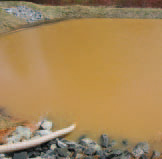
Each system is mobile to be able to move with the projects. DOT projects move linearly, meaning that once grading and excavation is completed in one area of the project, then it moves further down the roadway and begins again. The grading and excavating portion of construction generally has the highest probability of sedimentation. The water treatment systems high mobility helps reduce set up and take down cost associated with Active Treatment Systems and helps reduce the overall cost of treatment. The systems are set up to treat around 100 gallon per minute (gpm) on average. They average 8 hours a day, 3 days a week run time for an average weekly treatment between 140,000 and 150,000 gallons of sediment laden stormwater runoff.
Typical sediment in a holding pond is between 400 and 800 NTUs in turbidity and discharge averages around 30 to 35 NTUs. The systems have produced water to as low as 4 NTUs, but on cost-benefit rationale the 30 to 40 NTU range is targeted, which is safely below the discharge permit level. A lower NTU discharge level will likely be targeted for certain waters, like trout streams, as part of Special Protection Areas Best Management Practices. In which case, the contractors can adjust the systems for better performance.That better performance does add cost, so the cost-benefit ratio is monitored.
All three systems together have treated over 19 million gallons of stormwater. Assuming an example 500 mg/L loading rate, these systems have prevented 79,105 lbs or 39.55 tons of sediment from entering waters of the US and prevented that much further damage on the Maryland region and the Chesapeake Bay.
The US EPA has recently submitted a draft of entitled “Effluent Limitation Guidelines and Standards for the Construction and Development Point Source Category” which would require better focus and accountability on standard erosion and sediment control BMPs, but also proposes to require large sites (30+ acres) with certain soil types (10% or more clay materials) and higher erosivity factors (R >= 50) to meet a numeric discharge requirement (13 NTUs). The treatment trailers being used today on the ICC project have the capability of meeting this discharge requirement. “Pro-Active” erosion control techniques upstream from the project minimize the need for “Re-Active” sys•tems downstream to treat stormwater. Polymers/PAM/Polyacrylamide types are not erosion control and/or mulch control materials as they do not have a matrix and do not offer resistance to erosion but they are a viable option for removing sediment that has reached the site. The ICC contractors are pleased to know they are using the latest technology to provide the best discharge water quality with the least amount of harm to the environment and meet current regulations. L&W

